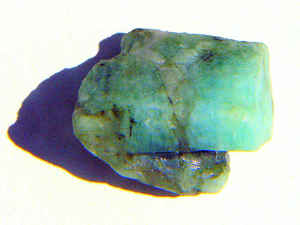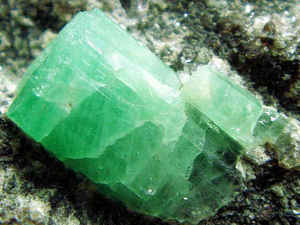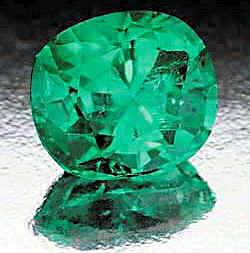

North Carolina Symbols
North Carolina State Precious Stone (Gemstone or Gem)
Emerald

Be3Al2(SiO3)6 - Beryllium Aluminium Silicate
Adopted in 1973.
The General Assembly of 1973 designated the emerald, Be3Al2(SiO3)6 - Beryllium Aluminium Silicate, as the official State Precious Stone. (Session Laws, 1973, c. 136).
A greater variety of minerals, more than 300, have been found in North Carolina than in any other state.
These minerals include some of the most valuable and unique gems in the world. An emerald crystal weighing 1869 carats, thought to be the largest ever found in North America, was unearthed in late 2003 at a mine in Hiddenite, near Statesville. A 71-carat stone found on the same property yielded two finished stones--the 7.85 carat Carolina Prince that sold for $500,000, and the Carolina Queen (18.88 carats).
Emerald: North Carolina Precious Stone

Emerald is a gemstone, and a variety of the mineral beryl (Be3Al2(SiO3)6) colored green by trace amounts of chromium and sometimes vanadium. Beryl has a hardness of 7.5-8 on the 10-point Mohs scale of mineral hardness. Most emeralds are highly included, so their toughness (resistance to breakage) is classified as generally poor.
Emeralds, like all colored gemstones, are graded using four basic parameters-the four Cs of Connoisseurship: Color, Cut, Clarity and Carat weight.
DESCRIPTION
Emerald is a beryllium aluminum silicate. It is a medium green, dark green, or blue-green gem-quality variety of the mineral beryl, and the most precious stone in the beryl group. Pure beryl is white; trace amounts of impurities such as chromium, and sometimes iron or vanadium give emerald its color. Aquamarine, morganite, and heliodor are beryls of other colors.
FORMATION AND OCCURRENCE
Beryls occur in granites and granite pegmatites and rarely in granular igneous rocks. They are also found in dark-colored metamorphic rocks composed of iron and magnesium, in low- to high-temperature hydrothermal mica schist veins, and in cavities in rhyolite. Emeralds occur with pyrite, calcite, and quartz.
These minerals include some of the most valuable and unique gems in the world. A brilliant, transparent form of the mineral beryl, the emerald occurs in nature as a hexagonal crystal with a deep green color and a glass-like luster. In North Carolina, emeralds are found most often in Mitchell and Alexander Counties in deposits with quartz, feldspar, mica, and sometimes hiddenite.
The May birthstone is the most precious in the beryl group.
NAME ORIGIN
The word "emerald" comes via the Old French word meaning "emerald" or simply "green gemstone."
Emerald is a medium to dark green beryl which derives its color from chromium and vanadium. Always rich green in color, most emeralds have many "inclusions," or flaws, and are typically oiled to fill cracks and generally improve appearance. It is used in rings, necklaces, pendants and bracelets.
MAY Birthstone: Emerald

Emerald is regarded as the traditional birthstone for May, as well as the traditional gemstone for the astrological signs of Taurus, Gemini and sometimes Cancer, and is the most highly prized of all gems. The emerald's name is indirectly derived from the Greek word "smaragdos,"a term applied to several kinds of green stones. The history of emeralds can be traced back to antiquity. They were worn by royalty in Babylon and Egypt. Tools dating back to 1300 BC, during the reign of Rameses II, have been found in emerald mines in Egypt. Queen Cleopatra's emeralds were believed to originate from mines in Southern Egypt, near the Red Sea. The Aztecs and Incas also coveted emeralds, and the Moguls of India revered them so much they inscribed the gems with sacred text to be used to ward off evil. With its vibrant green hue, emerald is the symbol of rebirth, immortal love, wisdom and future success. It is said that emerald will bring good fortune and youth. According to legend, wearing emeralds cures a wide variety of ailments, including low IQ, poor eyesight, and infertility, but also allows the wearer to predict the future.
North Carolina Law
The law designating the emerald as the official North Carolina state precious stone is found in the North Carolina General Statutes, Chapter 145 Section 145-8
H. B. 82 CHAPTER 136
AN ACT TO DESIGNATE THE EMERALD THE PRECIOUS STONE OF THE STATE.
The General Assembly of North Carolina enacts:
Section 1. Chapter 145 of the North Carolina General Statutes is amended by adding the following section thereto:
"§ 145-8. The Emerald is hereby adopted as the official State precious stone of the State of North Carolina."
Sec. 2. This act shall become effective upon the opening of the National Gem Show in Charlotte June 28, 1973.
In the General Assembly read three times and ratified, this the 5th day of April, 1973.
Emerald Gemological Properties
- Species: Emerald - beryl
- Chemical Formula: Al2Be3Si6O18 - Aluminum beryllium silicate
- Crystal Structure: Hexagonal; hexagonal prisms
- Color: Emerald green to green to slightly bluish or yellowish-green
- Hardness: 7.50 to 8.0
- Refractive Index: 1.565 to 1.602
- Density: 2.67 to 2.78
- Cleavage: Indistinct
- Transparency: Transparent to opaque
- Double Refraction or Birefringence: -0.006
- Luster: Vitreous
- Fluorescence: Usually none
Minerals, & Gems

Gemstone, Minerals, Rocks





